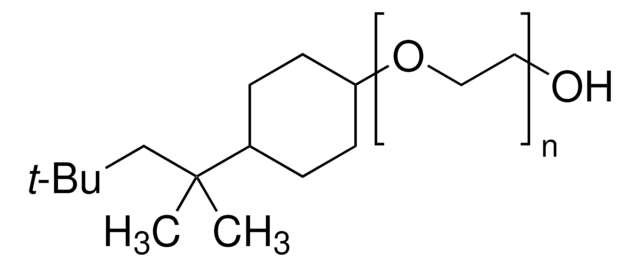282103
Triton™ X-100 reduced
Synonym(s):
Polyoxyethylene (10) isooctylcyclohexyl ether
About This Item
Recommended Products
Quality Level
refractive index
n20/D 1.473 (lit.)
density
1.029 g/mL at 25 °C (lit.)
SMILES string
CC(C)(C)CC(C)(C)C1CCC(CC1)OCCOCCOCCOCCOCCOCCOCCO
InChI
1S/C28H56O8/c1-27(2,3)24-28(4,5)25-6-8-26(9-7-25)36-23-22-35-21-20-34-19-18-33-17-16-32-15-14-31-13-12-30-11-10-29/h25-26,29H,6-24H2,1-5H3
InChI key
QQJNBKDKLMCALZ-UHFFFAOYSA-N
Looking for similar products? Visit Product Comparison Guide
Related Categories
General description
In biochemical and cell biology research, Triton™ X-100 is instrumental in solubilizing membrane-bound proteins and isolating lipid rafts. Its unique properties allow for the preservation of the native conformation of proteins obtained from cellular membranes in solution. Triton™ X-100 reduced is derived from the full hydrogenation of the benzene moiety of TX-100 to a cyclohexane derivative. This modified version, RTX-100, has demonstrated potential in enhancing enzyme digestion and influencing the photoisomerization of bacteriorhodopsin, showcasing its versatility and utility in advanced research applications.
Application
- as a component of LB-TT for the extraction of total protein from rat brains
- in ADP-Glo assay and Cytophos adenosine triphosphatase (ATPase) assay
- in phosphate-buffered saline (PBS) solution for the permeabilization of fibroblasts in 5′ ethynyl uridine staining, immunofluorescence, and immunolabeling
Features and Benefits
- Non-ionic surfactant
- Reduced polyoxyethylene content (~10)
- Improves solubility and dispersibility of substances
- Excellent wetting properties
- Enhances emulsification
- High purity product for research applications
Other Notes
Legal Information
comparable product
Signal Word
Warning
Hazard Statements
Precautionary Statements
Hazard Classifications
Aquatic Chronic 2 - Eye Irrit. 2 - Skin Irrit. 2 - STOT SE 3
Target Organs
Respiratory system
Storage Class Code
10 - Combustible liquids
WGK
WGK 3
Flash Point(F)
235.4 °F - closed cup
Flash Point(C)
113 °C - closed cup
Personal Protective Equipment
Choose from one of the most recent versions:
Already Own This Product?
Find documentation for the products that you have recently purchased in the Document Library.
Customers Also Viewed
Global Trade Item Number
| SKU | GTIN |
|---|---|
| 282103-5G | 4061826226162 |
| 282103-25G | 4061826226148 |
Our team of scientists has experience in all areas of research including Life Science, Material Science, Chemical Synthesis, Chromatography, Analytical and many others.
Contact Technical Service





